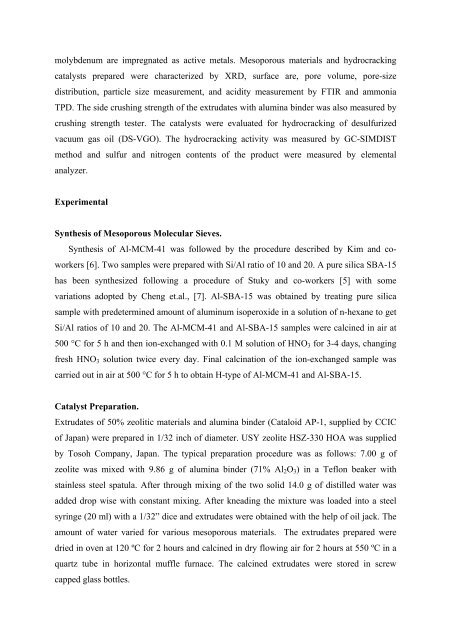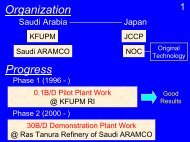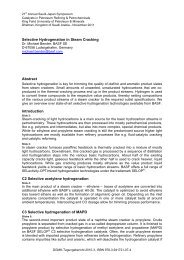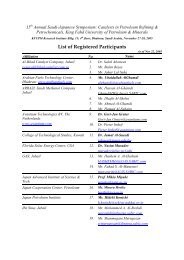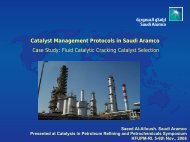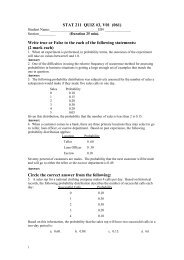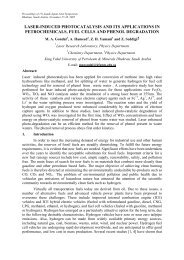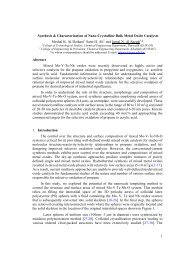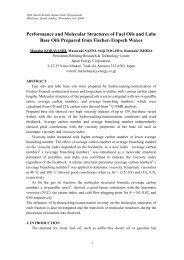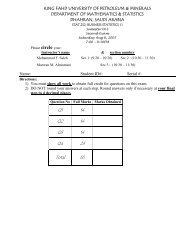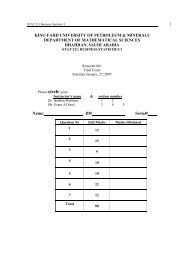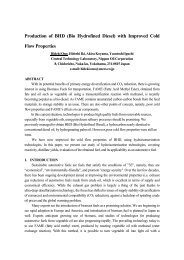preparation of mesoporous molecular sieve based hydrocracking
preparation of mesoporous molecular sieve based hydrocracking
preparation of mesoporous molecular sieve based hydrocracking
You also want an ePaper? Increase the reach of your titles
YUMPU automatically turns print PDFs into web optimized ePapers that Google loves.
molybdenum are impregnated as active metals. Mesoporous materials and <strong>hydrocracking</strong><br />
catalysts prepared were characterized by XRD, surface are, pore volume, pore-size<br />
distribution, particle size measurement, and acidity measurement by FTIR and ammonia<br />
TPD. The side crushing strength <strong>of</strong> the extrudates with alumina binder was also measured by<br />
crushing strength tester. The catalysts were evaluated for <strong>hydrocracking</strong> <strong>of</strong> desulfurized<br />
vacuum gas oil (DS-VGO). The <strong>hydrocracking</strong> activity was measured by GC-SIMDIST<br />
method and sulfur and nitrogen contents <strong>of</strong> the product were measured by elemental<br />
analyzer.<br />
Experimental<br />
Synthesis <strong>of</strong> Mesoporous Molecular Sieves.<br />
Synthesis <strong>of</strong> Al-MCM-41 was followed by the procedure described by Kim and coworkers<br />
[6]. Two samples were prepared with Si/Al ratio <strong>of</strong> 10 and 20. A pure silica SBA-15<br />
has been synthesized following a procedure <strong>of</strong> Stuky and co-workers [5] with some<br />
variations adopted by Cheng et.al., [7]. Al-SBA-15 was obtained by treating pure silica<br />
sample with predetermined amount <strong>of</strong> aluminum isoperoxide in a solution <strong>of</strong> n-hexane to get<br />
Si/Al ratios <strong>of</strong> 10 and 20. The Al-MCM-41 and Al-SBA-15 samples were calcined in air at<br />
500 °C for 5 h and then ion-exchanged with 0.1 M solution <strong>of</strong> HNO 3 for 3-4 days, changing<br />
fresh HNO 3 solution twice every day. Final calcination <strong>of</strong> the ion-exchanged sample was<br />
carried out in air at 500 °C for 5 h to obtain H-type <strong>of</strong> Al-MCM-41 and Al-SBA-15.<br />
Catalyst Preparation.<br />
Extrudates <strong>of</strong> 50% zeolitic materials and alumina binder (Cataloid AP-1, supplied by CCIC<br />
<strong>of</strong> Japan) were prepared in 1/32 inch <strong>of</strong> diameter. USY zeolite HSZ-330 HOA was supplied<br />
by Tosoh Company, Japan. The typical <strong>preparation</strong> procedure was as follows: 7.00 g <strong>of</strong><br />
zeolite was mixed with 9.86 g <strong>of</strong> alumina binder (71% Al 2 O 3 ) in a Teflon beaker with<br />
stainless steel spatula. After through mixing <strong>of</strong> the two solid 14.0 g <strong>of</strong> distilled water was<br />
added drop wise with constant mixing. After kneading the mixture was loaded into a steel<br />
syringe (20 ml) with a 1/32” dice and extrudates were obtained with the help <strong>of</strong> oil jack. The<br />
amount <strong>of</strong> water varied for various <strong>mesoporous</strong> materials. The extrudates prepared were<br />
dried in oven at 120 ºC for 2 hours and calcined in dry flowing air for 2 hours at 550 ºC in a<br />
quartz tube in horizontal muffle furnace. The calcined extrudates were stored in screw<br />
capped glass bottles.


